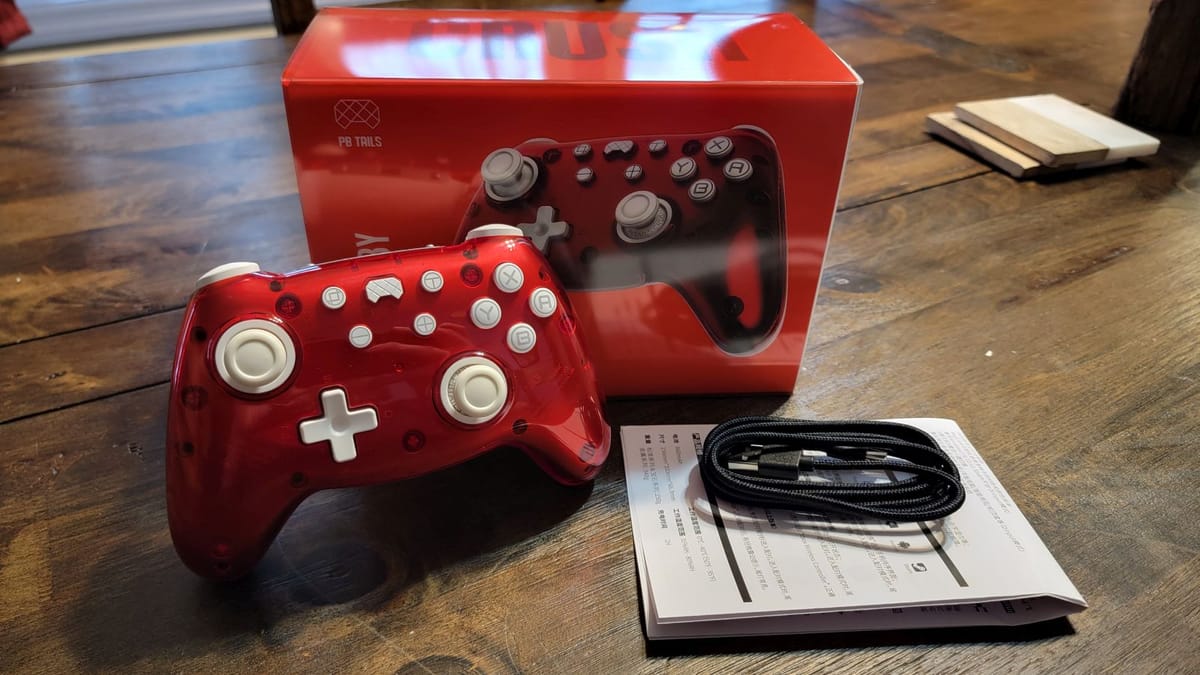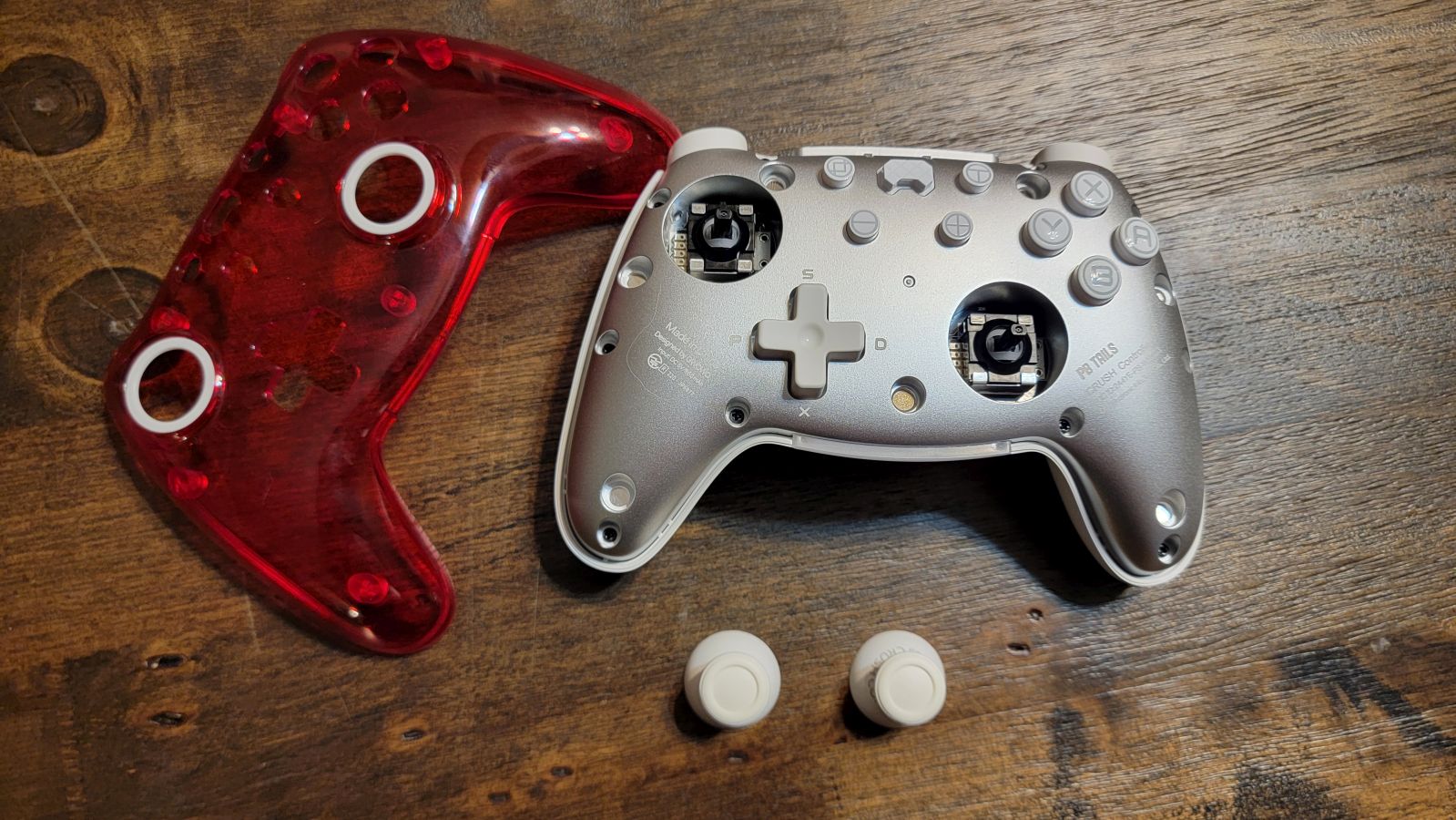
If you’re anything like me, you’ve likely amassed a stockpile of controllers over the years, mainly due to each console generation generally requiring the use of their own proprietary controller. Thankfully, a few consoles, such as the Nintendo Switch, are far more lenient with their controller layout, allowing for non-first-party companies to create controllers capable of being used with multiple devices. Enter PB Tails’ Crush controller, which can switch between the Nintendo Switch, Windows, Steam, Raspberry Pi, Android, and iOS with ease, all while boasting a comfortable design, unique customization features, and accurate controls.
The first thing you’ll notice about PB Tails’ Crush controller is its eye-catching packaging and its sleek, semi-transparent design which allows the user to customize the MagCase, the thumbsticks, and even select the colors which emanate from the controller. While the use of RGB lighting on a controller is nothing new, here it is surprisingly well done, subtly adding to the overall polish of the controller while not being bright enough to distract during play sessions. I appreciated how easy PB Tails made it for the user to switch the color scheme of both the light strip underneath the controller and the center button on a whim; the user simply holds in the “T” button while spinning the left thumbstick to cycle through the colors, and then releases the “T” button once they land on the color of their choice. A few other parts of the controller, such as the X, Y, A, and B buttons, also glow faintly, but cannot be customized. Instead, the X button lights up in blue, the Y lights up green, the A lights up red, and the B lights up yellow.


Further adding to the customization is the ability to swap MagCases and thumbsticks. The MagCase, which is the outer layer on the controller, easily pops off and can be replaced with several other designs and colors available through PB Tails. The thumbsticks can also be removed with surprising ease, allowing the user to swap to a color which better suits their current MagCase. Unlike some controllers which offer the ability to swap pieces, I never felt as if I would damage the controller during the removal process for either the MagCase or the thumbsticks. Both pieces came off with ease and locked back into place gently, at no time requiring any force on my end. Overall, I was impressed with these customization features, even if I am not normally one who dives into that aspect of a controller.
A sleek look and comfortable controller design can only garner so much good will for a controller if it fails in other aspects, such as connectivity or input accuracy, but thankfully the PB Tails’ Crush controller excels in both departments. The Crush controller offers three methods of connectivity: 2.4g wireless, 5.0 Bluetooth, or via the included USB charging cable. I tested all three methods with great success, though I mainly stuck to using the wireless and Bluetooth capabilities.


Connecting to any device takes mere seconds, sticking with PB Tails’ dedication to ensuring that the Crush controller is user friendly no matter how it is being used. To connect wirelessly to the Nintendo Switch you simply slide the toggle switch located on the top of the controller to the “S” position, and then hold down the pairing button, located on the opposite side of the controller, for three seconds while on the “Change Grip / Order” settings screen. Within seconds you’ll be paired and ready to play. To connect to Windows, Steam, Android, Raspberry Pi, or iOS, you will need to slide the toggle switch over to the “X” setting and again hold the pairing button for three seconds. At no point during my testing did the controller fail to connect near instantaneously, and at no point did any of the devices fail to recognize the controller. I’ve messed around with my share of Bluetooth and wireless technology, and rarely have I had as smooth an experience as I had with the Crush controller.
Most importantly, during my play testing the Crush controller never experienced any noticeable input lag, no matter if I was connected via Bluetooth or wireless, and no matter if I was playing on the Switch, my phone, or computer. I fully expected to run into lag at some point, but came away thoroughly impressed by the Crush’s consistently high performance across all devices.


I tested on Android by playing Mighty Doom and had a great time. During the in-between mission screens and when I wanted to use my special weapons, I did have to touch the screen to advance, so be aware that your mileage will vary as to whether the controller will suffice for all phone inputs. That said, the game itself played smoothly and the Crush controller provided me with a clear tactical advantage over the original touch controls, which involve having to slide your finger across the screen for movement, so needing to touch the screen occasionally did not in any way dampen the experience. I was also pleasantly surprised to find that while connected to your phone you can use the controller to scroll through your apps and to doom scroll through your favorite social media with ease, if you so choose.
On the Nintendo Switch I tested using Donkey Kong Country Tropical Freeze and Shovel Knight Treasure Trove, both games which often require precise movements, and came away thoroughly impressed with the Crush’s performance. At no time was there any noticeable lag, and despite testing for long periods, the controller never felt uncomfortable due to its lightweight, yet still sturdy construction. The Crush pulls its design from previous Xbox controllers, a smart move considering the Xbox controller features arguably the most popular controller layout, which automatically puts players at ease while playing due to a sense of familiarity. The Crush just feels right in your hands, avoiding the pratfall of feeling cheap or poorly constructed like many other non-first-party options.
While the Crush controller works perfectly fine as a basic controller replacement, it also has a few tricks up its sleeve to help it stand out from the crowd, including a turbo mode, subtle vibrations functions, and a 6-axis motion sensor. The turbo mode is activated by simply pressing the “T” button followed by any button you’d like to set to turbo, and then repeating these same steps to turn turbo off. The vibration and motion sensor come into play naturally if called for during gameplay. While none of these features will sell a controller on their own, they are always welcome additions, and here they add to an already impressive package.
Overall, I found PB Tails’ Crush controller to be a welcome addition to my already overflowing controller bin, and well worth the cost thanks to its ease of use, comfortable and familiar design, flawless input, and customization options.
PB Tails Crush Controller
Excellent
PB Tails’ Crush controller exceeded my expectations, providing me with a controller capable of tackling numerous devices with ease, while allowing me to replace multiple older controllers at once. Its ease of use, great button layout, range of customization features, lag-free input, lightning quick connectivity, and nicely implemented RGB lighting, allow the Crush controller to stand out amongst a crowded field of controllers vying for attention.
Pros
- Connects via wireless and Bluetooth quickly and flawlessly
- Comfortable and familiar design
- Nice range of customization features
- No noticeable lag no matter how you are connected
Cons
- RGB lighting isn’t for everyone, and the controller seems to lack an option to turn off the lights completely
